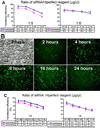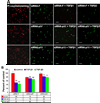Targeted inhibition of p57 and p15 blocks transforming growth factor beta-inhibited proliferation of primary cultured human limbal epithelial cells
- PMID: 16943770
- PMCID: PMC2906388
Targeted inhibition of p57 and p15 blocks transforming growth factor beta-inhibited proliferation of primary cultured human limbal epithelial cells
Abstract
Purpose: To evaluate the role of cyclin-dependent kinase inhibitors p57 and p15 in transforming growth factor (TGF)-beta1 or TGF-beta2 inhibited proliferation of primary cultured human limbal epithelial cells using short interfering RNA (siRNA).
Methods: Primary cultured human limbal epithelial cells were treated with TGF-beta1 or TGF-beta2 for 6 and 24 h, and total RNA extracted for RT-PCR and real-time PCR using primers for p21, p27, and p57 (CipP/Kip family) and p15 and p19 (INK4 family). Proteins were extracted for western blot analysis of p57 and p15. For RNA interference, primary cultured human limbal epithelial cells were transfected with annealed double-stranded siRNA (67 nM) specific for p57, p15, or siRNA-Fluorescein (siRNA-F; as a negative control) followed by treatment with TGF-beta1 or TGF-beta2 at 1 ng/ml. P57 and p15 were quantitatively detected by real-time PCR and western blot; and immunolocalized by immunofluorescent staining. The effects of TGF-beta1 or TGF-beta2 on cell proliferation were evaluated by BrdU incorporation and MTT assay.
Results: TGF-beta1 or TGF-beta2 significantly inhibited primary cultured human limbal epithelial cell proliferation measured by BrdU incorporation and MTT assay. TGF-beta1 or TGF-beta2 upregulated the expression of p57 and p15 mRNA and protein, but did not effect the expression of p19, p21, or p27. The siRNA transfection efficiency of these cells was 75% and no cellular toxicity was observed by 24 h. The TGF-beta1 or TGF-beta2 stimulated expression of p57 and p15 mRNA were markedly blocked by siRNA-p57 or siRNA-p15, respectively, but not by siRNA-F. The TGF-beta1 or TGF-beta2 suppression of epithelial proliferation measured by BrdU incorporation and MTT generation was increased to near normal levels by siRNA-p57 or siRNA-p15. Western blot and immunofluorescent staining showed that levels of p57 and p15 proteins were equally reduced in the cytoplasm and nucleus.
Conclusions: These findings demonstrate that TGF-beta1 and/or TGF-beta2 inhibit proliferation of primary cultured human limbal epithelial cells and that p57 and p15 play roles in this process.
Figures





References
-
- Massague J. The transforming growth factor-beta family. Annu Rev Cell Biol. 1990;6:597–641. - PubMed
-
- Honma Y, Nishida K, Sotozono C, Kinoshita S. Effect of transforming growth factor-beta1 and -beta2 on in vitro rabbit corneal epithelial cell proliferation promoted by epidermal growth factor, keratinocyte growth factor, or hepatocyte growth factor. Exp Eye Res. 1997;65:391–396. - PubMed
-
- Wilson SE, He YG, Weng J, Zieske JD, Jester JV, Schultz GS. Effect of epidermal growth factor, hepatocyte growth factor, and keratinocyte growth factor, on proliferation, motility and differentiation of human corneal epithelial cells. Exp Eye Res. 1994;59:665–678. - PubMed
-
- Nishimura T, Toda S, Mitsumoto T, Oono S, Sugihara H. Effects of hepatocyte growth factor, transforming growth factor-beta1 and epidermal growth factor on bovine corneal epithelial cells under epithelial-keratocyte interaction in reconstruction culture. Exp Eye Res. 1998;66:105–116. - PubMed
Publication types
MeSH terms
Substances
Grants and funding
LinkOut - more resources
Full Text Sources
Other Literature Sources
Molecular Biology Databases
Miscellaneous

